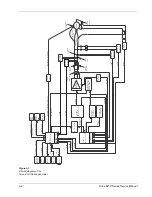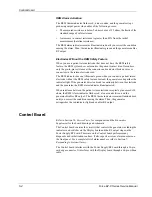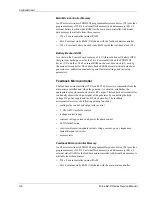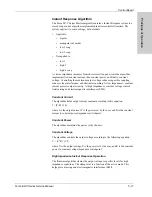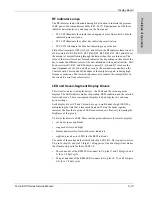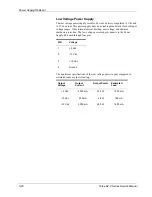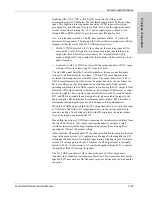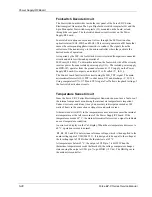
Display Board
5-14
Force EZ-C Series Service Manual
U5 drives the seven-segment displays that indicate power settings:
•
DS1 and DS2 indicate the bipolar power setting
•
DS3–DS5 indicate the cut power setting
•
DS6–DS8 indicate the coag power setting.
The anodes of these displays each connect to only one digit line of the driver. The
effective duty cycle is 1/8 for each seven-segment display.
Some filtering components are associated with U5 and U6. Bypass capacitors
C19, C20, C21, and C22 connect b 5V and DGND. C19 and C21 have a
relatively small capacitance value of 0.1 µF to filter higher frequency noise. C20
and C22 have a relatively large capacitance value of 47 µF to supply the large
spikes of current for the LEDs. The multiplexing action of the drivers, which
typically occurs at 250 Hz, generates the large current spikes.
Resistors R18, R20, R22, R24, R26, R28, R30, R32, R34, R36, and R38 reduce
the input impedance of the display driver inputs as seen by the main
microcontroller on the Control board. This rounds off the edges of these digital
signals, reducing high frequency emissions. The lowered impedance also reduces
the susceptibility of the circuit to noise from other circuits.
Mode Selection Switches
The mode selection switch circuitry uses five discrete switches (S2, S4, S5, S7,
and S8). S2 toggles the front panel footswitch control between bipolar output or
single-pin accessory output. S4 and S5 select the pure and blend cut modes. S7
and S8 select the low or high coag modes.
FETs Q2, Q3, and Q6 select a bank of switches for the main microcontroller to
read. When one of the digital signals (BANK0–BANK2) is high, the
corresponding FET pulls its output low allowing the main microcontroller to read
any switch closure in that bank as a logic low. If a switch is not pressed, a pull-up
resistor on the Control board pulls the corresponding output (KBD_D6 or
KBD_D7) high and the main microcontroller reads it as a logic high. Resistors
R16, R43, and R53 pull the outputs of Q2, Q3, and Q6 high when they are off.
Pull-up resistors R15, R41, and R51 attach to gates Q2, Q3, and Q6 to reduce the
input impedance as seen by the main microcontroller on the Control board. This
rounds off the edges of these digital signals, reducing high frequency emissions.
The lowered impedance also reduces the susceptibility of the circuit to noise from
other circuits.
Schottky diodes (Z1–Z5) prevent false switch readings if someone presses
multiple switches. For example, when S4, S5, and S7 are all closed and the
BANK2 signal is high, Q6 pulls KBD_D6 low through S7. If Z2 is not placed in
line with S4, the output of Q3 is pulled low through S4, and KBD_D7 is pulled
low through S5. To the main microcontroller, S7 and S8 appear to be pressed;
however, since S8 is not pressed, this reading is false. Schottky diodes are used
because the logic low level placed on KBD_D6 or KBD_D7 must be below 0.8
volts to be read correctly.



